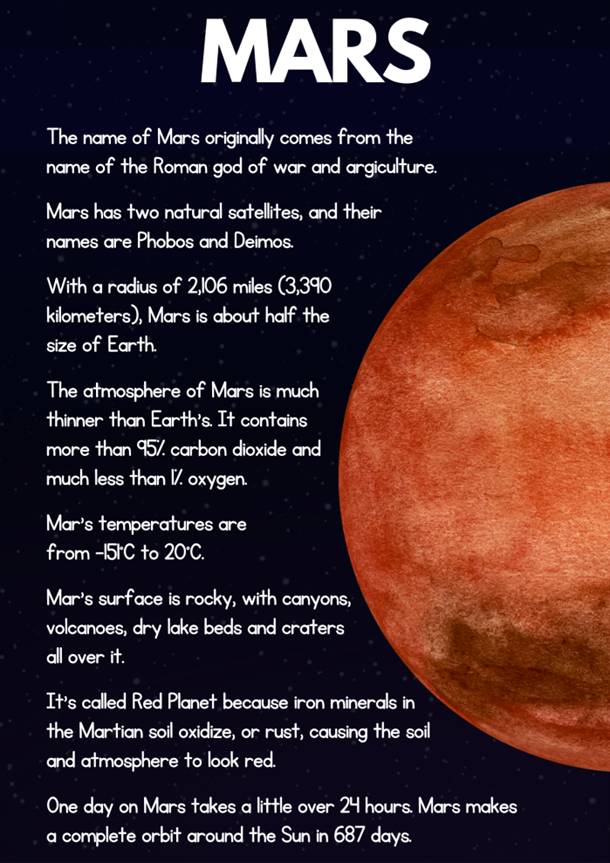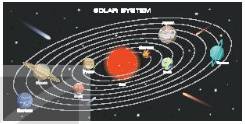Hãy nhập câu hỏi của bạn vào đây, nếu là tài khoản VIP, bạn sẽ được ưu tiên trả lời.

1. moons
2. rocky surfaces
3. objects
4. huge
5. rings
1. Many of the planets in our solar system have moons.
(Nhiều hành tinh trong hệ mặt trời của chúng ta có mặt trăng.)
2. The four inner planets are quite small and have rocky surface.
(4 hành tinh ở trong nhỏ hơn và có bề mặt đá gồ ghề.)
3. The asteroid belt has millions of rocky objects.
(Vành đai của tiểu hành tinh có hàng triệu vật thể bằng đá.)
4. The outer planets are huge and mostly made up of gas.
(Những hành tinh bên ngoài lớn và chủ yêu được tạo thành từ khí.)
5. These outer planets all have thick layers of clouds and rings around them.
(Những hành tinh bên ngoài này có những lớp mây dày và những vành đai xung quanh chúng.)

1. This time next week we WILL BE TAKING an english test
2. By the end of this year i WILL HAVE BEEN LEARNT english for 6 years
3. Beagle 2 - the first british spaceship to Mars - IS GOING TO LOOK FOR signs of aliens this time next month
4. Astronauts WILL HAVE TRAVELED to planets outside our solar system by 2050.
5. I expect your english WILL BE IMPROVED a lot by the time you got back from england
6. Nasa WILL HAS DEVELOPED new aircraft to replace space shuttles by the end of this decade


The Solar System is made up of all the planets that orbit our Sun. In addition to planets, the Solar System also consists of moons, comets, asteroids, minor planets, dust and gas. The inner solar system contains the Sun, Mercury, Venus, Earth and Mars. The main asteroid belt lies between the orbits of Mars and Jupiter. The planets of the outer solar system are Jupiter, Saturn, Uranus and Neptune (Pluto is now classified as a dwarf planet).
Everything in the Solar System orbits or revolves around the Sun. The Sun contains around 98% of all the material in the Solar System. The larger an object is, the more gravity it has. Because the Sun is so large, its powerful gravity attracts all the other objects in the Solar System towards it. At the same time, these objects, which are moving very rapidly, try to fly away from the Sun, outward into the emptiness of outer space.
The result of the planets trying to fly away, at the same time that the Sun is trying to pull them inward is that they become trapped half-way in between. Balanced between flying towards the Sun and escaping into space, they spend eternity orbiting around their parent star.
The Planets orbit in the same direction (counter-clockwise looking down from above the Sun’s North Pole); all but Venus, Uranus and Pluto also rotate in that same sense. Mercury has the fastest elliptical orbit,
48 km per second. It has the shortest revolution at 88 days. Pluto has an orbital speed of 5 km per second. It takes 248 years for Pluto to make one complete revolution.
The Solar System has eight planets, arranged in order of distance from closest to farthest from the sun: Mercury, Venus, Earth, Mars, Jupiter, Saturn, Uranus, Neptune. Mercury is the planet closest to the sun and it's also the smallest, only slightly larger than Earth's moon. It's a planet in the solar system named after the Roman gods. The 2nd Planet in the Solar System – Venus is the second planet from the Sun, Venus is the twin size of Earth. The surface has many different mountains and volcanoes.It is name after the roman god mercury , who was the fast flying messenger of the god. Earth is the third planet closest to the solar system, and the only planet with life. The fourth planet closest to the sun is Mars and the second smallest planet in the solar system. It is named after the roman god of war. The 5th planet in the Solar System – Jupiter is a gas giant. This is the largest planet in the system our sun. This is a planet named after the god of thunder and lightning. 6th Planet in the Solar System – Saturn is the sixth planet from the Sun, Saturn is best known for its rings. It is name after roman god of agriculture. Uranus - the seventh planet in the Solar System has extremely strange and interesting features. Uranus is the first planet in the Solar System to be discovered using only a telescope. 8th planet in the Solar System – Neptune is the eighth planet from the sun, Neptune is about the same size as Uranus. It is name after the roman god of the sea

RELATIVE CLAUSE
Our solar system is in a galaxy. The galaxy is called the Milky Way.
-> Our solar system is in a galaxy that is called the Milky Way
→ Our solar system is in a galaxy that is called the Milky Way.

Tham khảo
Hello everyone, today I will talk about Mars, the 4th planet in our solar system. The name of Mars originally comes from the name of the Roman god of war and agriculture. It may not seem like these two things go together, but they do. Mars protected those who fought for their communities and stayed home to raise crops for food. Mars has two natural satellites, and their names are Phobos and Deimos. With a radius of 2,106 miles (3,390 kilometers), Mars is about half the size of Earth. The atmosphere of Mars is much thinner than Earth's. It contains more than 95% carbon dioxide and much less than 1% oxygen. Mar's temperatures are from -151°C to 20°C. Mars is colder than Earth. If you were to stand on the surface of Mars on the equator at noon, it would feel like spring at your feet and winter at your head. Mar's surface is rocky, with canyons, volcanoes, dry lake beds and craters all over it. It's called Red Planet because iron minerals in the Martian soil oxidize, or rust, causing the soil and atmosphere to look red. One day on Mars takes a little over 24 hours. Mars makes a complete orbit around the Sun in 687 days. Thanks for listening.

1. How do solar panels work ?
=> ( mượn trợ động từ )
2.despite being young ,Emily knows how to use water economically.
=> ( giống chủ ngữ làm V- ing , lượt bỏ một chủ ngữ đằng trước )
3.Ms.kate used to walk to the market
=> ( sau used to động từ dạng nguyên mẫu )
4.there will probably be flying cars in the future
=> ( probably là trạng từ , trạng từ thì đứng sau will


theo mk thì cả 2 câu đều sai vì bị động mà lại thiếu tobe
A solar panel will be bought by Shara system
Câu bị động đúng ko nhỉ ????